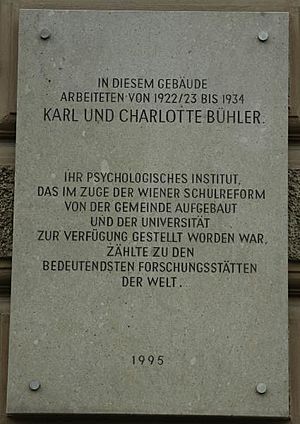Charlotte Bühler facts for kids
Quick facts for kids
Charlotte Bühler
|
|
|---|---|
 |
|
| Born |
Charlotte Berta Malachowski
December 20, 1893 |
| Died | February 3, 1974 (aged 80) |
| Citizenship | German (1893–1945) American (1945–1974) |
| Alma mater | University of Freiburg University of Berlin University of Munich |
| Known for | Work on child psychology, adolescent psychology, gerontopsychology |
| Spouse(s) |
Karl Bühler
(m. 1916–1963) |
| Children | Ingeborg, Rolf |
| Scientific career | |
| Fields | Child psychology Developmental psychology |
| Institutions | Technical University of Dresden University of Vienna University of Oslo Minneapolis General Hospital Los Angeles County Hospital University of Southern California |
| Thesis | Über Gedankenentstehung: Experimentelle Untersuchungen zur Denkpsychologie ("On the origin of thought: Experimental studies on the psychology of thought") (1918) |
Charlotte Bühler (born Charlotte Berta Malachowski; December 20, 1893 – February 3, 1974) was an important psychologist. She was German-American and focused on how people grow and change throughout their lives. This field is called developmental psychology.
Contents
A Life of Learning and Discovery
Early Life and Education
Charlotte Berta Malachowski was born in Berlin on December 20, 1893. She was the older of two children. Her father, Hermann Malachowski, was a government architect, and her mother was Rose Kristeller. Her family was Jewish.
After finishing high school in 1913, Charlotte studied science and humanities. She attended the University of Freiburg and the University of Berlin. In 1918, she earned her doctorate degree from the University of Munich. Her research was about how thoughts are formed.
Marriage and Family
In 1916, Charlotte married Karl Bühler. They had two children, a daughter named Ingeborg (born 1917) and a son named Rolf (born 1919). Karl Bühler passed away in 1963 in Los Angeles, California. Charlotte became ill in 1970. She moved back to Stuttgart, Germany, in 1971 to be with her children. She died there at the age of 80.
Academic Journey
Teaching in Vienna
In 1923, Charlotte Bühler began teaching at the University of Vienna. By 1929, she became an associate professor. Both Charlotte and Karl Bühler worked closely together in Vienna. They had a special laboratory to do their research.
Over the next few years, Charlotte Bühler became very well-known. Her research and writings led to the "Viennese child psychology school." This school focused on understanding children's minds. Today, the Charlotte Bühler Institute still continues her work.
Moving to the United States
In March 1938, Charlotte Bühler was in London. She learned that Nazi Germany had taken over Austria. Her husband, Karl Bühler, was arrested because he spoke out against the Nazis. Charlotte worked hard to get him released. After about six and a half weeks, he was free. The family reunited in Oslo, Norway, in October 1938. Because Charlotte Bühler was Jewish, they decided to move to the United States.
In 1938, both Bühlers were offered jobs at Fordham University in New York City. However, these jobs didn't work out. Karl Bühler then accepted a job in Saint Paul, Minnesota. Charlotte Bühler stayed in Norway for a while. She had already accepted a job at the University of Oslo. She also had a position at a teachers' academy in Trondheim.
In 1940, her husband asked her to join him in the United States. She moved to Saint Paul just before Norway was invaded.
Work in America
In 1942, Charlotte Bühler became a senior psychologist. She worked at the Minneapolis General Hospital. In 1945, she became an American citizen. She then moved to Los Angeles, California. There, she became the chief psychologist at the Los Angeles County Hospital. She held this job until she retired in 1958. During this time, she also taught Psychiatry at the University of Southern California. After retiring, she started her own private practice in Beverly Hills, California.
Important Work and Ideas
Understanding Young People
In 1922, Charlotte Bühler published a book called Das Seelenleben des Jugendlichen. This means "The mental life of young people." In this book, she looked at how teenagers develop. This was a new way to study adolescent psychology. She also created "Bühler's world test." This is a special test where people use miniature objects to build a scene. It helps psychologists understand their thoughts and feelings.
The Vienna School of Child Psychology
In Vienna, Charlotte Bühler focused on babies and teenagers. She started a way of doing research called the "Vienna School." This involved careful experiments, keeping diaries, and observing behavior. With her assistants, she created intelligence tests for children. These tests are still used today!
Studying Life from Start to Finish
In 1933, she wrote Der menschliche Lebenslauf als psychologisches Problem. This means "The course of human life as a psychological problem." This was the first German book to include old age as a part of psychological development. It helped create the field of gerontopsychology, which studies the psychology of aging. She was a true pioneer in this area.
Human Needs and Psychology
In the United States, Charlotte Bühler developed ideas about four "basic tendencies" in humans. These are:
- The desire for personal satisfaction.
- Adjusting to get security.
- Being creative or expressing yourself.
- The need for order in life.
She helped create humanistic psychology. This field focuses on human potential and growth. She worked alongside other famous psychologists like Carl Rogers and Abraham Maslow.
Honors and Recognition
Many places and institutions honor Charlotte Bühler's contributions:
- The Charlotte-Bühler-Institut was founded in Vienna in 1992. It focuses on practical research about infants.
- A special plaque honors both Charlotte and Karl Bühler. It was put up in 1995 at the Palais Epstein in Vienna.

- There are streets named after Charlotte Bühler in Dresden and Emsdetten, Germany. Vienna also has a Charlotte Bühler way.
See also
 In Spanish: Charlotte Bühler para niños
In Spanish: Charlotte Bühler para niños

